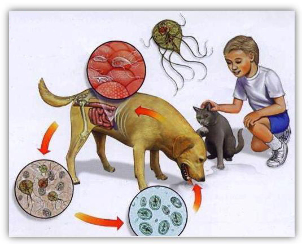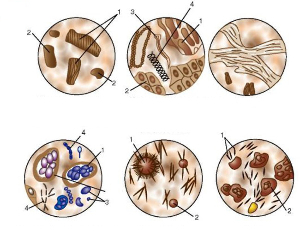Parasites are microorganisms that survive by feeding on their host organism. Living in the human body, they cause serious health problems and can be fatal due to their reproduction.
Parasitic organisms are generally classified into two types:
- Zooparasites, including parasitic worms (helminths, flatworms), arachnids, ticks, molluscs, etc.
- Phytoparasites are parasitic plants, viruses, pathogenic fungi, etc.
Parasites include certain types of viruses that lead a parasitic lifestyle at the expense of a foreign organism.
Unfortunately, even modern society is not able to fully protect itself from infection by parasites, but if you do a timely analysis of parasites, you can avoid them multiplying and get rid of them without causing serious health damage.
Symptoms of parasites in the human body
Parasites enter the human body through natural openings such as the mouth, genitals, and anus. Less commonly, helminths penetrate the skin, urogenital system, or ear.
The pathogens of the disease can be spread through food and water (most helminths), physical contact with an infected person (pinworm), soil, air or dust (globular worms).
Most often, invasive diseases are asymptomatic, in no way show me their presence. But in the case of excessive reproduction, signs of various diseases appear, which usually do not indicate the presence of parasites, which makes treatment significantly more difficult because they are unable to make a correct diagnosis.
However, there are a number of signs that suggest that parasites are present in the human body.
Including
- common headache;
- regular joint pain;
- unreasonable muscle pain;
- common cold;
- allergic skin rashes;
- severe bowel movements and constipation;
- gnashing of teeth during sleep;
- low efficiency, constant fatigue;
- increased nervousness;
- insomnia;
- cracked corner;
- shortness of breath;
- disruption of the digestive system;
- sharp weight fluctuations;
- the fragility of nail plates;
- itching in the anus.
Cancerous tumors
It should be borne in mind that parasitic diseases can cause serious problems. For example, large numbers of helminths can coalesce and cause intestinal obstruction.
Parasites can also cause chronic cell damage, cancer, anemia, or jaundice.
Signs of parasites in children

Symptoms to identify the presence of parasitic organisms in a child:
- violation of the usual diet (loss of appetite, gluttony);
- increase in body temperature;
- allergic rash;
- cheerfulness, weakness, nervousness;
- dark circles under the eyes;
- pallor of the skin;
- bowel problems (diarrhea with mucous membranes or constipation);
- Nausea and vomiting mainly in the morning.
Most parasites are unable to leave the human body alone. Therefore, if at least one of the above symptoms occurs, be sure to contact a local therapist or pediatrician, examine for parasites, and treat helminths.
Diagnosis of invasive diseases
Diagnosis of invasive diseases involves the detection of parasites (pinworms, amoebas) and their reproductive products (larvae, oocytes). A blood test, feces, tissue scraping, or sputum test is pre-assigned. To test the samples, perform:
- histological examinations;
- immunological tests;
- blood macroscopy;
- vegetative resonance tests.
Investigating the presence of parasites in children

Before visiting a professional, parents often think about what tests should be done to identify the child's parasites and which method will give more accurate results. Analysis of invasive diseases in children is prescribed based on the location and type of parasites.
Most often assigned to:
- blood test by ELISA;
- serological test;
- scraping or smearing by PCR;
- blood tests in adults and children.
Blood testing is the most effective type of research that allows you to determine the exact picture of the disease, the type of helminth, and the ability to reproduce. This makes it possible to determine the presence of ascariasis, toxoplasma, cysticercosis, amoebae, and lichen.
One type of such test is the ELISA blood test, which makes it possible to assess the plasma levels of certain antibodies, to determine the stage of infection, to study the body's immune response to helminths and to identify certain elements in the blood.
Benefits of ELISA research:
- accuracy of the result, regardless of the laboratory assistant's education and experience;
- high sensitivity of analysis with up to 90% accuracy; Use
- to get a complete picture of the disease and the number of parasites;
- parasites are diagnosed in the early stages of development;
- ability to monitor disease dynamics;
- Determination of the presence of toxic products in the blood.
The color of the reagent and the intensity of the hue of the sample are taken into account when interpreting the result. The ratio of antibodies to parasitic antigens is measured by the level of IgM and IgG markers in the blood. High concentrations of IgM and IgG are maintained throughout the presence of helminth samples.
If the blood test shows high IgM levels, the disease is acute. IgG antibodies speak of a chronic form of the disease.
Disadvantages of blood tests to diagnose parasitic diseases:
- ELISA
- blood test results are obtained within 7 days, while scraping, smear, and fecal samples are obtained after 1-2 days;
- research must be performed in a special laboratory for a fee.
We recommend that you give blood on an empty stomach, especially in the first half of the day; it is advisable to exclude medication 12-15 hours before blood collection. Parents are advised to prepare their child in advance.
Stool analysis

Microscopic analysis of feces may be required to pre-determine helminth samples in the conventional manner. The test determines the presence of parasitic eggs in the faecal fragment.
The most accurate result is what 3 tests show this week.
For the most accurate result, a stool fragment should be submitted to a laboratory for analysis no later than 45 minutes after bowel movement.
Parasites such as:
during the scan- tapeworm;
- topics;
- round helmets.
This type of diagnostics, because it is fairly simple, cannot set 100% accuracy. This is due to the fact that parasites in the human body cannot lay eggs for long periods of time.



























